Top News

July 22, 2017 Ryukyu Shimpo
At 2:00 p.m. on July 22, in front of the gates of Camp Schwab in Henoko, Nago, citizen groups formed a ‘human chain’ to protest the construction of the new U.S. base that is part of the replacement of U.S. Marine Corps Air Station Futenma in Ginowan. The protestors called for the reclamation of Oura Bay to be blocked. According to the organizer, about 2,000 people took part in the protest rally.
Participants bound their hands together in a 1.2 kilometer-long line along the fence and surrounded the base. They raised their voices in protest, saying, “No new Henoko base”.
The human chain protest was organized by the Okinawa Council Opposing Base Relocation Within Okinawa consisting of peace groups in the prefecture.
At the beginning of the rally, the participants released about 1,000 balloons into the sky as an expression of their desire to create peace.
The participants did a “Mexican wave” to convey the movement of energy from one group to the next group.
They called for the new base construction to be stopped, holding placards saying, “No Henoko Base”.
Songs were performed at the rally.
Nago City Mayor Susumu Inamine criticized the government for forcing to the continuation of the construction of the new base, saying, “Is it really a law-governed state?”. He encouraged the participants, saying, “Each person is doing their best to regain local autonomy and democracy.”
Diet members from Okinawa inspired participants with speeches about solidarity.
(English translation by T&CT)
Go to Japanese

July 20, 2017 Ryukyu Shimpo
At 7:20 p.m. on July 19, the U.S. Air Force conducted parachute training over the water in the Tsuken Jima Training Area in Uruma City. At two separate times, a total of six parachutes were seen descending from special mission aircraft Lockheed MC-130. Parachute trainings had been conducted three-months in a row starting this January, making this training the fourth one. In January, the training was conducted without Japan being notified, causing people from the city and prefecture to strongly protest the training. However, now that training has become a regular occurrence, it has been receiving strong backlash from local citizens.
Located near the training area are mozuku seaweed farms and routes for fishing and commercial boats. Liner ships that connect Tsuken Island and the main island of Okinawa also come and go in the nearby area. Due to these reasons, for the citizens’ safety and peace of mind, the city strongly urges canceling the training every time it happens.
With the 1996 Special Action Committee on Okinawa (SACO) Agreement, the Yontan Airfield, where parachute trainings had been previously conducted, was relocated to Ie Island. In response to this, the prefecture has been requesting that the U.S. Air Force not conduct parachute trainings over the water in the Tsuken Jima Training Area.
Regarding the difference in opinion between the prefecture and country, Uruma City Mayor Toshio Shimabukuro said, “Both sides are not seeing eye to eye, while the local people continue to become more upset. We’d prefer if (the trainings) did not happen, but while the water area near Tsuken Island is offered, we’d at least want the U.S. military to take safety into consideration and maintain peace and quiet.” The mayor thereby requested more detailed plans for trainings and for the U.S. Air Force to notify them beforehand.
(English translation by T&CT and Chelsea Ashimine)
Go to Japanese
July 20, 2017 Ryukyu Shimpo
Washington Special Correspondent Yukiyo Zaha reporting
On July 18 during LDP Secretary General Toshihiro Nikai’s visit to the United States, he had a discussion with Chairman Mac Thornberry (R-TX) of the U.S. House Committee on Armed Services. In a press conference following the discussion Nikai said, “I expressed [to Mr. Thornberry] that the Okinawa problem is a matter of concern for Japan.” He mentioned that he and Thornberry shared identical views in terms of recognizing the extreme importance of the Okinawa problem. They did not specifically address construction of a new base in Henoko, Nago, as a replacement facility for Futenma Air Station, or the U.S. military realignment in Japan.
During the press conference Nikai mentioned U.S. military issues in Okinawa: “I spoke candidly, saying that I have always recognized the Okinawa problem spanning the pre- and post-war periods as greatly important in Japanese politics, and from here on out if Japan and the U.S. have opportunities to mutually cooperate I want to do so. [Mr. Thornberry] replied that the Okinawa problem is extremely important and he will remain concerned with it.”
(English translation by T&CT and Erin Jones)
Go to Japanese
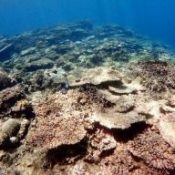
July 21, 2017 Ryukyu Shimpo
The Ministry of the Environment’s Naha Environment Bureau announced on July 20 the results of a June survey of 35 locations in the Sekisei shoko coral reef, Japan’s largest reef, located between Ishigaki and Iriomote islands in Okinawa. The results showed an average coral cover of 12.5%, a sharp decline from the 29.5% cover indicated in the same survey taken from July-August of the previous year.
The average bleaching rate was 19.7%. A surveyor from the Naha Environment Bureau indicated that the decline in cover rate was an effect of last year’s wide-spread bleaching phenomenon, noting, “This summer we need to take particular care with areas in the reef that were heavily bleached or declared dead in last year’s survey.”
It is believed that the warm ocean temperatures last summer were the cause of the wide-spread bleaching throughout Okinawa, resulting in bleaching in over 90% of the Sekisei shoko coreal reef, and 70% being declared dead. The situation had become so bad that both the Ministry of the Environment as well as researchers from both Okinawa and elsewhere elected to declare an emergency.
Regarding this summer’s results, a representative from the Ministry of the Environment noted that, “at this point in time, [the results] do not confirm a serious bleaching phenomenon,” however they indicated their persistent concern of whether or not the coral could endure having not completely recovered from the previous year’s grueling conditions.
After last year’s bleaching, the Ministry of Environment’s Nature & Parks department conducted a supplemental survey around Miyako, Ishigaki, and Iriomote Islands from June 28 through July 8. In many of the surveyed locations, the amount of dead staghorn coral was glaring, and at two points off the western coast of Ishigagi Island, the coverage rate had decreased a staggering 40% compared to the previous survey. In Sakiyama Bay of the coast of Iriomote Island, there were three locations were bleaching exceeded 70%.
(English translation by T&CT and Sam Grieb)
Go to Japanese
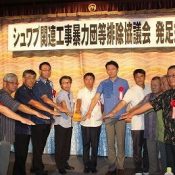
July 19, 2017 Ryukyu Shimpo
(Nago) On July 19, with the aim of eliminating organized crime groups from the new base construction work at U.S. Camp Schwab in Henoko, Nago, representatives from Taisei Corporation, Penta-Ocean Construction Co. Ltd. and other construction companies contracted to do the work, as well as from the Okinawa Defense Bureau and the Okinawa prefectural police, met at the Nago Izumonden in Ohigashi, Nago for an inauguration ceremony of a consultative committee called the “Council to Eliminate Organized Crime Groups etc. from Schwab-Related Construction”, to be chaired by Kotaro Nakahara.
Forty-five people attended the ceremony. Taisei Corporation work director Nakahara, who will serve as chairman of the council, addressed the attendees, saying, “We must make utmost efforts to eliminate organized crime groups and other antisocial forces. I believe that we can eliminate organized crime groups and the like from the Schwab construction more effectively by always remaining on alert and receiving support from the prefectural police and other relevant agencies.” Penta-Ocean Construction general director and council co-chair Kenji Sato read aloud a declaration of elimination of organized crime groups, which stipulated: (1) Firmly refusing any unjust demands by antisocial forces or the like, (2) Taking firm measures against violence, threats and other similar conduct, and (3) Strengthening cooperation among councilmembers and with the police and other relevant agencies.
(English traslation by T&CT and Sandi Aritza)
Go to Japanese
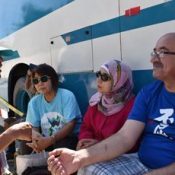
July 15, 2017 Ryukyu Shimpo
On July 14, about 26 citizens gathered in front of the gate of the U.S. Marine Corp’s Camp Schwab in Henoko, Nago, where there is ongoing construction work towards a new base that is part of replacement base for U.S. Marine Corps Air Station Futenma.
A total of 117 construction-related vehicles entered and exited the base from 9:00 a.m. to 1:40 p.m in a constant stream.
Palestinian medical doctor Salim Anati, 57, who engages in medical support activities for refugee camps in Palestine, visited the front of the gate and expressed solidarity with sit-in protesters.
Salim said, “Both Palestine and Okinawa are under the same situation of occupation. I want friendship between the two places to be built, and I want to tell many people about the facts.”
At the coast of Camp Schwab, workers and divers employed by the Okinawa Defense Bureau submerged crushed stones into the sea to construct the K9 sea wall.
Work to strengthen the sea wall by using heavy machinery goes on. People who are against the construction of the new base boarded two boats and 14 canoes and protested.
(English translation by T&CT)
Go to Japanese

July 14, 2017 Ryukyu Shimpo
By Shinji Sano
Photographer Kunisada Azuma from Nago City won the grand prize out of 100 entries in the 70th Japan Portrait Photographers Association (JPPA) Exhibition held on June 5. It is the second time the award has gone to an Okinawan in 19 years. The JPPA exhibition has taken place every year since 1948, and photographers specializing in portrait photography from all over the country participate. The prize-winning work is titled “Tanaka and a girl.” Higashi shot it three years ago in Myanmar’s rural area. “Tanaka” is a Myanmar cosmetic product made from tree resin. Azuma’s impressive work shows Tanaka’s whiteness and a girl’s tightly-closed mouth and powerful gaze.
Azuma started working as a photographer at the age of 23. Currently, he serves as the president of the Prefectural Photography Association. He began visiting Myanmar six years ago and photographing portraits of everyday people. Azuma said, “In Myanmar, people’s livelihood is a matter of life and death. I strongly feel the radiance of people’s lives.”
Azuma feels strongly about portrait photography. “Photography is a tool to preserve memories. After decades, memories revive when you see the picture.” The Great East Japan Earthquake occurred in 2011. Azuma was shocked while watching the TV showing the affected area. A woman was shedding tears and stroking a small picture over and over.
“For the woman, who lost everything, the photograph, which captured the memory of her family, was the only treasure. I reaffirmed that the photograph has that role.” Azuma also said, “I want to radicate the culture in Japan to take portraits at the milestones of one’s life. I want people to look at pictures with family and enjoy memories forever.”
(English translation by T&CT and Megumi Chibana)
Go to Japanese

July 16, 2017 Ryukyu Shimpo
On July 15, Chairman of the Okinawa Peace Movement Center Hiroji Yamashiro and others reported back about the Human Rights Council in Geneva, Switzerland in June, where Yamashiro delivered a statement. The All Okinawa Council for Human Rights hosted a debriefing session in Naha, with about 190 people in attendance.
The debriefing session speakers reported that the issues of the new base being built in Henoko as a replacement facility for Futenma Air Station and the violation of Okinawans’ human rights were raised at the UN. They claimed that they want to deepen ties with the international community and act as a conduit for Okinawans’ voices in advance of Japan’s upcoming Universal Periodic Review (UPR) by the Human Rights Council in November.
Yamashiro addressed riot police squads’ interactions with citizens sit-in protesting new base construction, saying that it is beyond Okinawans’ understanding how the Henoko site has been illegally agreed upon. He likened the way Okinawan citizens are being carelessly mowed down and injured to how Ryukyuans were made to surrender by soldiers when the Ryukyu Kingdom was annexed by Japan in the Meiji Period. In addition, he voiced his intent to bring attention to these issues as long as righteousness is on the Okinawan people’s side.
The lawyer Nozomi Kanetaka criticized the Japanese government’s objection to the UN special rapporteur’s report, saying: “The rapporteur is requesting a dialogue. However, the Japanese government’s rejective attitude does not seem like that of a member state to the Human Rights Council.”
Since Japan’s courts have ruled in favor of the national government in previous cases regarding Henoko, Kanetaka rhetorically asked if the U.S.-Japan security treaty is the only thing Japan protects under international law. He wants to discuss how to use what has been gained through this UN action in future court proceedings.
Among others, Professor Jun Shimabukuro and Professor Eiichi Hoshino of the University of the Ryukyus and reporter Takashi Abe of the Okinawa Times also spoke at the debriefing session.
(English translation by T&CT and Erin Jones)
Go to Japanese
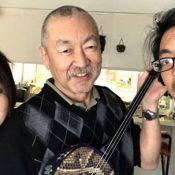
July 17, 2017 Ryukyu Shimpo
By Sadao Tome
Los Angeles – Joseph Yoshimasu Kamiya, 30, is the head of the Culture Committee at the Okinawa Association of America (OOA). The only son of OOA President Eddy Kamiya, Joseph Kamiya is a 4th generation Okinawan born in Los Angeles. The younger Kamiya is involved in event organization for the OOA, manages their social media sites, and sends newsletters to young Uchinanchu worldwide. He also spends a lot of time thinking about how Okinawans who have taken root in Los Angeles spend their lives, and how the global Uchinanchu community can stay connected.
In recent years, the OOA has turned its focus towards its youth, and through potlucks and other social events they have been working on strengthening the social bond between young Uchinanchu. They invite people from Okinawa engaged in cultural activities, and hold performances and movie screenings. In June, Harold Kameya invited director John Junkerman to their screening of his documentary, Okinawa: Urizun no ame, and Kamiya handled all the preparations and newspaper advertising with the Culture Committee.
Until recently, Joseph Kamiya had almost no interest in Okinawan art or culture. However, in 2009 Kamiya was moved by the Kumi Odori Dance “Shohashi,” which was performed at the OOA’s 100th anniversary celebration and choreographed by Daiichi Hirata. Soon after the performance he joined the Los Angeles Terukina Choichi Association and began practicing the sanshin. Since Kamiya already played the guitar, the sanshin, a similar stringed instrument, came easy to him, and he improved quickly. Kamiya enthused, “I had my sights set on the newcomer award at the art competition.”
From July 2016 through June 2017 Kamiya studied abroad in Okinawa, where he learned about sanshin repair at the Nakamine Sanshin shop in Naha, part of the Okinawa Sanshin Crafters Co-op. Sanshin brought by 1st generation Okinawans to Los Angeles have become old, and there is no one who can repair them. Kamiya reflected, “Becoming useful in this regard would be invaluable. I learned about the kuruchi (Ryukyu ebony) that the neck of the sanshin are made from. My studies were broadcast on NHK and other television programs, and it was definitely a meaningful experience.”
For the Okinawa Association of America, membership of the next generation of Okinawans is increasing, making clerical work increasingly difficult, so Kamiya has taken to doing the paper pushing for the OOA. “I would like to be a leader of the OOA in the future,” he said, indicating his decision to carry the future of the OOA on his shoulders.
(Translation T&CT and Sam Grieb)
Go to Japanese

July 13, 2017 Ryukyu Shimpo
On July 13, the nationwide liaison council Opposition to Henoko Soil Hauling held a study meeting from the point of view of environmental conservation at the Okinawa Prefectural Assembly building in Naha City, where about 15 people were in attendance.
Advisor Ichiro Yuasa, who lectured at the meeting, spoke about land reclamation work that the Japanese government is pushing forward in Henoko, Nago City, for the construction of a replacement facility to Futenma Air Station. He pointed that this action not only goes against the National Biodiversity Strategy of Japan, it also disturbs this ecosystem peculiar to Okinawa. In addition, he addressed the importance of effectively utilizing the prefectural regulations on preventing introduction of invasive species through land reclamation materials (or soil regulations) in order to strengthen the check system through wide-area coordinated efforts with the municipal governments in places where soil is being collected.
Yuasa cited the example of brown widow spiders, a known invasive species, being found in the soil hauled from Amami Oshima for Naha Airport’s second runway construction project. This was the first situation to which the soil regulations applied, and threw the regulations’ efficacy into question. He voiced his opinion that to set a precedent for contingencies, the prefectural government should conduct thorough examinations on the introduction of the invasive species, and put a check system in place following extermination operations.
Furthermore, Yuasa shared his hope that assembly members would understand the threat posed by invasive species, improve the efficacy of soil regulations, and if possible promote regional biodiversity strategies through establishing a liaison council with municipalities in other prefectures.
Co-representative Etsuko Abe of Opposition to Henoko Soil Hauling pointed out that the Japanese government, which should be striving for environmental conservation in accordance with the National Biodiversity Strategy, is acting inconsistently with its own strategy by pressing forward with conduct that is environmentally destructive. She said that the environmentally destructive conduct related to military base construction does not only affect Okinawa, but extends to the soil collection sites around the Inland Sea.
Opposition to Henoko Soil Hauling is affiliated with 18 organizations that are making efforts focused in the Inland Sea region.
(English translation by T&CT and Erin Jones)
Go to Japanese
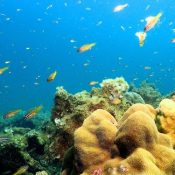
July 14, 2017 Ryukyu Shimpo
On July 13, the Anti-Helicopter Base Council Diving Team Rainbow surveyed the coral reef at the bottom of the ocean near the tip of the K9 seawall. This is in response to the new base construction in Henoko, Nago City, or the relocation of the Futenma Air Station. Construction is currently taking place between the land and offshore areas of Oura Bay. The diving team checked the Porities lutea coral, which is part of the reef. This area is about 20 meters away from the tip of the seawall and has a high likelihood of it being destroyed by rocks being thrown into the ocean due to the construction.
The Porities lutea coral is 30 centimeters in length and 45 centimeters in width. In the surrounding areas, yellow and pink fish were seen swimming around. According to 67-year-old Osamu Makishi, representative of Team Rainbow, who photographed the coral reef said that other coral could also be seen in the surrounding areas. “If the seawall continues to grow, the coral and fish will die. Should we really be reclaiming land from the sea?” he said resentfully.
(English translation by T&CT and Chelsea Ashimine)
Go to Japanese










 Webcam(Kokusai Street)
Webcam(Kokusai Street)


